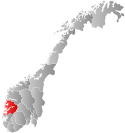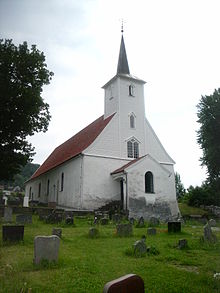Hosanger
Hosanger Municipality
Hosanger herad | |
|---|---|
 View of the lake Kossdalsvatnet | |
 Hordaland within Norway | |
 Hosanger within Hordaland | |
| Coordinates: 60°34′30″N 05°28′39″E / 60.57500°N 5.47750°E | |
| Country | Norway |
| County | Hordaland |
| District | Nordhordland |
| Established | 1 Jan 1838 |
| • Created as | Formannskapsdistrikt |
| Disestablished | 1 Jan 1964 |
| • Succeeded by | Osterøy and Lindås municipalities |
| Administrative centre | Hosanger |
| Area (upon dissolution) | |
| • Total | 228 km2 (88 sq mi) |
| Population (1964) | |
| • Total | 2,442 |
| • Density | 11/km2 (28/sq mi) |
| Time zone | UTC+01:00 (CET) |
| • Summer (DST) | UTC+02:00 (CEST) |
| ISO 3166 code | NO-1253[1] |
Hosanger is a
History
The
During the 1960s, there were many municipal mergers across Norway due to the work of the Schei Committee. On 1 January 1964, the municipality of Hosanger was dissolved and its lands were divided as follows amongst its neighbors:[3]
- All of Hosanger located north of the Lindås Municipality.
- All of Hosanger located on the island of Osterøy Municipality.
Name
The municipality (originally the
Government
During its existence, this municipality was governed by a
Municipal council
The
| Party name (in Nynorsk) | Number of representatives | |
|---|---|---|
| Labour Party (Arbeidarpartiet) | 7 | |
| Conservative Party (Høgre) | 2 | |
| Joint List(s) of Non-Socialist Parties (Borgarlege Felleslister) | 7 | |
| Local List(s) (Lokale lister) | 1 | |
| Total number of members: | 17 | |
| Party name (in Nynorsk) | Number of representatives | |
|---|---|---|
| Labour Party (Arbeidarpartiet) | 6 | |
| Conservative Party (Høgre) | 2 | |
| Joint List(s) of Non-Socialist Parties (Borgarlege Felleslister) | 8 | |
| Local List(s) (Lokale lister) | 1 | |
| Total number of members: | 17 | |
| Party name (in Nynorsk) | Number of representatives | |
|---|---|---|
| Labour Party (Arbeidarpartiet) | 6 | |
| Joint List(s) of Non-Socialist Parties (Borgarlege Felleslister) | 9 | |
| Local List(s) (Lokale lister) | 1 | |
| Total number of members: | 16 | |
| Party name (in Nynorsk) | Number of representatives | |
|---|---|---|
| Labour Party (Arbeidarpartiet) | 6 | |
| Joint List(s) of Non-Socialist Parties (Borgarlege Felleslister) | 10 | |
| Total number of members: | 16 | |
| Party name (in Nynorsk) | Number of representatives | |
|---|---|---|
| Labour Party (Arbeidarpartiet) | 6 | |
| Joint List(s) of Non-Socialist Parties (Borgarlege Felleslister) | 10 | |
| Total number of members: | 16 | |
| Party name (in Nynorsk) | Number of representatives | |
|---|---|---|
| Labour Party (Arbeidarpartiet) | 5 | |
| Local List(s) (Lokale lister) | 11 | |
| Total number of members: | 16 | |
| Note: Due to the German occupation of Norway during World War II, no elections were held for new municipal councils until after the war ended in 1945. | ||
Hosanger Church

The historic Hosanger Church was built in 1796. It is located in the village of Hosanger and it served as the main church for the municipality. It is a Romanesque-style church constructed of brick and stone. On the site there once was a stave church dating back to the Middle Ages. It was first mentioned in historical records in 1329. Later, a wooden church was constructed. The wooden church was struck by lightning and burned down on Christmas Day 1795. From 1863 until 1865, the church was extended to the west. The vestry extension on the south side of the church was built in 1962–1964.[12]
Notable residents
- Norwegian Constitutionof May 1814
- folklorist
- Christian Democratic Party of Norway
- editor
See also
References
- Store norske leksikon (in Norwegian). Kunnskapsforlaget.
- Store norske leksikon. "Hosanger"(in Norwegian). Retrieved 23 April 2014.
- ^ ISBN 9788253746845.
- ^ Rygh, Oluf (1910). Norske gaardnavne: Søndre Bergenhus amt (in Norwegian) (11 ed.). Kristiania, Norge: W. C. Fabritius & sønners bogtrikkeri. p. 325.
- Store norske leksikon (in Norwegian). Kunnskapsforlaget. Retrieved 1 January 2023.
- ^ "Kommunevalgene og Ordførervalgene 1959" (PDF) (in Norwegian). Oslo: Statistisk sentralbyrå. 1960. Retrieved 16 February 2020.
- ^ "Kommunevalgene og Ordførervalgene 1955" (PDF) (in Norwegian). Oslo: Statistisk sentralbyrå. 1957. Retrieved 16 February 2020.
- ^ "Kommunevalgene og Ordførervalgene 1951" (PDF) (in Norwegian). Oslo: Statistisk sentralbyrå. 1952. Retrieved 16 February 2020.
- ^ "Kommunevalgene og Ordførervalgene 1947" (PDF) (in Norwegian). Oslo: Statistisk sentralbyrå. 1948. Retrieved 16 February 2020.
- ^ "Kommunevalgene og Ordførervalgene 1945" (PDF) (in Norwegian). Oslo: Statistisk sentralbyrå. 1947. Retrieved 16 February 2020.
- ^ "Kommunevalgene og Ordførervalgene 1937" (PDF) (in Norwegian). Oslo: Statistisk sentralbyrå. 1938. Retrieved 16 May 2020.
- ^ "Hosanger kyrkjelyd". Den norske kirke - Kirkerådet (in Norwegian).

